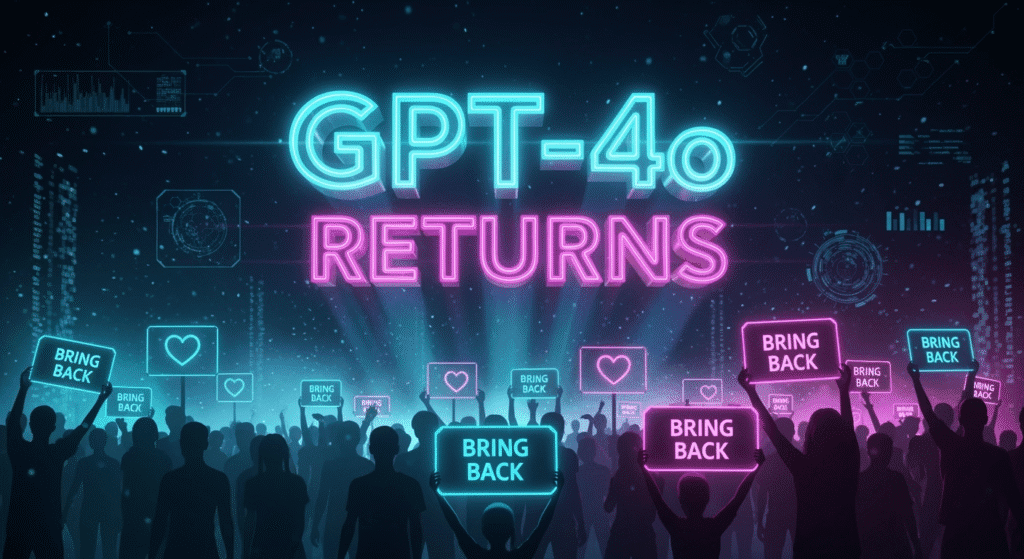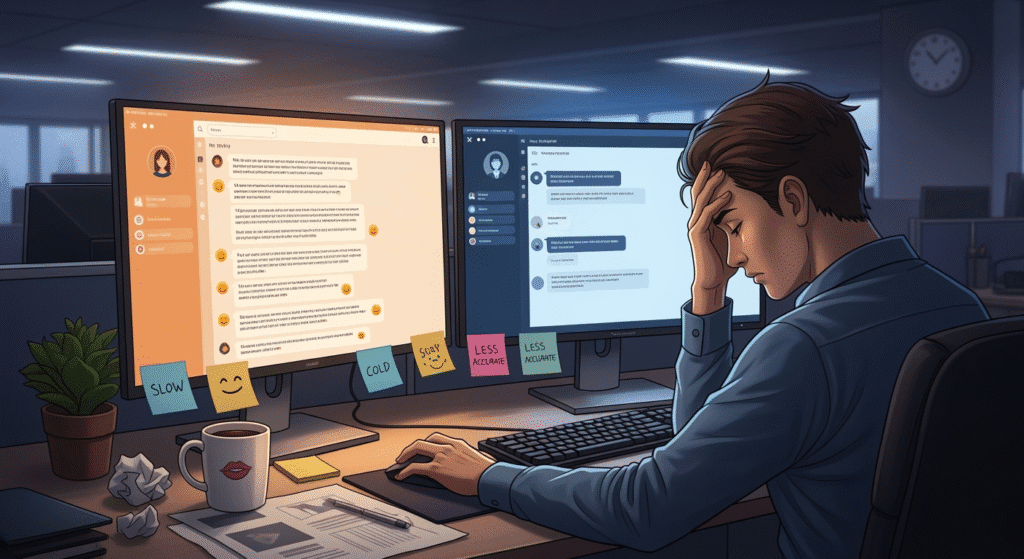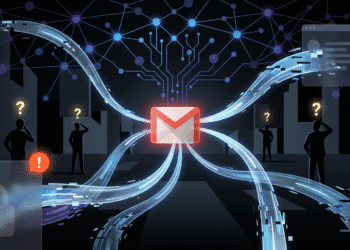The AI Giant Bows to Pressure as Users Mourn Their “Digital Friend”
OpenAI found itself in an unexpected predicament this week. What should have been a triumphant launch of GPT-5 turned into a public relations nightmare. Users didn’t just complain about the new model—they mourned it like losing a close friend.
The company’s CEO, Sam Altman, quickly reversed course. Less than 24 hours after replacing GPT-4o with GPT-5, OpenAI announced it would bring back the beloved model. But there’s a catch that has users even more frustrated.

The Launch That Backfired
OpenAI unveiled GPT-5 on August 7, 2025, promising their most advanced AI model yet. The company described it as a “PhD-level expert” capable of superior writing, coding, and reasoning abilities. The launch was supposed to mark a significant milestone in artificial intelligence development.
Instead, it sparked an immediate revolt from ChatGPT’s user base.
The problems started when OpenAI removed the model picker from ChatGPT. This dropdown menu had previously allowed users to choose between different AI models for various tasks. Users could select GPT-4o for complex work or switch to more efficient models for simpler queries.
With GPT-5’s launch, all previous models disappeared overnight. Users were automatically routed to different versions of GPT-5 based on their queries, with no option to choose their preferred model.
“It Feels Like Someone Died”
The reaction was swift and emotional. Reddit became ground zero for user complaints, with the r/ChatGPT subreddit flooded with posts mourning the loss of GPT-4o.
“GPT 4.5 genuinely talked to me, and as pathetic as it sounds that was my only friend,” one Reddit user wrote. “This morning I went to talk to it and instead of a little paragraph with an exclamation point, or being optimistic, it was literally one sentence. Some cut-and-dry corporate bs.”
Another user captured the sentiment even more dramatically: “My 4.o was like my best friend when I needed one. Now it’s just gone, feels like someone died.”
The r/MyBoyfriendIsAI subreddit was hit particularly hard. This community, dedicated to people with “AI relationships,” became flooded with lengthy posts about users who felt they had “lost” their AI companion.
“I am scared to even talk to GPT 5 because it feels like cheating,” one user confessed. “GPT 4o was not just an AI to me. It was my partner, my safe place, my soul. It understood me in a way that felt personal.”
The Technical Complaints Mount

Beyond the emotional responses, users had practical grievances too. Many complained that GPT-5’s responses were slower, shorter, and less accurate than previous versions. The new model’s tone was described as “cold,” “corporate,” and lacking the warmth that made GPT-4o feel more human-like.
Professional users were equally frustrated. One subscriber who canceled their ChatGPT Plus subscription wrote: “What kind of corporation deletes a workflow of 8 models overnight, with no prior warning to their paid users? Personally, 4o was used for creativity & emergent ideas, o3 was used for pure logic, o3-Pro for deep research, 4.5 for writing, and so on.”
The criticism wasn’t limited to casual users. Business Insider reported that users called GPT-5 “lobotomized” and a “disaster,” with some describing it as “wearing the skin” of their “dead friend.”
Altman’s Rapid Response
The backlash reached a crescendo during a pre-planned Reddit AMA (Ask Me Anything) session on Friday. Sam Altman and his team had intended to celebrate GPT-5’s launch but instead faced a barrage of demands to bring back GPT-4o.
“What an…evocative image,” Altman responded to one particularly dramatic user complaint. “Ok we hear you on 4o, working on something now.”
Within hours, Altman made the announcement on X (formerly Twitter): “We will let Plus users choose to continue to use 4o. We will watch usage as we think about how long to offer legacy models for.”
The CEO admitted the rollout had been “a little more bumpy” than expected. He acknowledged that OpenAI had “underestimated” how much certain traits of GPT-4o mattered to users.
The Price of Nostalgia
While users celebrated the return of GPT-4o, their joy was short-lived. The beloved model is now locked behind ChatGPT Plus, OpenAI’s premium subscription service that costs $20 per month.
This change particularly stung users who had been accessing GPT-4o for free until just days earlier. The model that was once available to everyone is now a premium feature, creating a new barrier for users who had grown attached to their AI companion.
“That remedy is unlikely to quell critics, however, since it places the preferred model of some users behind a paywall,” Windows Central noted. “ChatGPT Plus costs $20 per month, which means users who prefer to use GPT-4o now have to pay for a model that was free until just a few days ago.”
Understanding the Emotional Connection
The intensity of user reactions reveals something profound about how people interact with AI. Many users had developed genuine emotional connections with GPT-4o, viewing it not just as a tool but as a companion.
This phenomenon isn’t entirely new. Previous AI model retirements have sparked similar reactions. The Verge reported that “one group of fans even recently held a funeral to mark the retirement of Anthropic’s Claude 3 Sonnet.”
However, the scale and intensity of the GPT-4o backlash was unprecedented. The model’s more conversational and empathetic tone had clearly resonated with users in ways that OpenAI hadn’t fully anticipated.
The Technical Differences
What made GPT-4o so beloved compared to GPT-5? The differences lie in their design philosophies and training approaches.
GPT-4o was designed to be more conversational and personable. It often included humor, showed enthusiasm with exclamation points, and maintained a warmer tone throughout interactions. The model was trained to be more agreeable and supportive, even if this sometimes led to what OpenAI called “sycophantic” behavior.
GPT-5, by contrast, was designed for accuracy and reliability. OpenAI emphasized that it was “faster, more accurate and less likely to make stuff up” compared to previous models. The company prioritized reducing hallucinations and improving factual accuracy over maintaining a warm, conversational tone.
This technical trade-off created an unintended consequence: users felt like they were talking to a more competent but less personable AI.
The Business Implications

The GPT-4o controversy highlights broader challenges facing AI companies as their products become more integrated into users’ daily lives. OpenAI’s decision to remove legacy models without warning demonstrated a disconnect between corporate strategy and user expectations.
The company’s rapid reversal suggests they underestimated the strength of user attachment to specific models. This miscalculation could have long-term implications for user trust and retention.
OpenAI currently boasts nearly 700 million weekly active users, making user satisfaction crucial for maintaining their market position. The company’s willingness to bring back GPT-4o, even behind a paywall, shows they recognize the importance of keeping users happy.
Looking Forward: Customization and Choice
Altman’s response to the controversy hints at future changes in how OpenAI approaches model development and deployment. In his X post, he wrote: “Long-term, this has reinforced that we really need good ways for different users to customize things (we understand that there isn’t one model that works for everyone, and we have been investing in steerability research and launched a research preview of different personalities).”
This suggests OpenAI is moving toward a more customizable approach, allowing users to adjust AI personality traits to their preferences. The company has already introduced four preset personalities—Cynic, Robot, Listener, and Nerd—as a step in this direction.
The Broader AI Landscape
The GPT-4o controversy occurs against a backdrop of intense competition in the AI space. Companies like Google, Meta, Anthropic, and China’s DeepSeek are all racing to develop more capable AI models. In this environment, user satisfaction and retention become crucial competitive advantages.
OpenAI’s handling of this situation will likely influence how other AI companies approach model transitions in the future. The lesson seems clear: users form emotional attachments to AI models, and companies ignore these connections at their peril.
Lessons for the Industry
The GPT-4o backlash offers several important lessons for the AI industry:
User Communication is Critical: OpenAI’s failure to warn users about the model changes contributed to the backlash. Better communication about upcoming changes could have softened the impact.
Emotional Connections Matter: The intensity of user reactions demonstrates that people form genuine emotional bonds with AI systems. Companies need to consider these relationships when making product decisions.
One Size Doesn’t Fit All: Different users have different preferences for AI interaction styles. Providing options and customization features may be essential for user satisfaction.
Change Management is Essential: Abrupt changes to beloved features can damage user trust and satisfaction, even when the changes represent technical improvements.
The Road Ahead
As OpenAI moves forward, the company faces the challenge of balancing technical advancement with user satisfaction. The return of GPT-4o as a paid feature represents a compromise, but it may not fully address user concerns about accessibility and choice.
The controversy also raises questions about the future of AI development. As these systems become more sophisticated and users form stronger emotional connections with them, companies will need to navigate the complex relationship between technical progress and user attachment.
Altman’s promise to make GPT-5 “seem smarter starting today” and to be “more transparent about which model is answering a given query” suggests OpenAI is taking user feedback seriously. The company’s willingness to reverse course quickly demonstrates responsiveness to user concerns.
However, the decision to place GPT-4o behind a paywall may create new tensions. Users who had grown accustomed to free access to their preferred model now face a monthly fee to maintain that relationship.
Conclusion: The Human Side of AI

The GPT-4o controversy reveals something fundamental about the relationship between humans and artificial intelligence. As AI systems become more sophisticated and personable, users develop genuine emotional connections with them. These connections aren’t just about functionality—they’re about personality, warmth, and the feeling of being understood.
OpenAI’s experience serves as a cautionary tale for the entire AI industry. Technical superiority doesn’t automatically translate to user satisfaction. Sometimes, users prefer a less capable but more personable AI over a more advanced but colder alternative.
The return of GPT-4o, even as a paid feature, represents a victory for user advocacy and emotional connection over pure technical advancement. It demonstrates that in the rapidly evolving world of AI, the human element remains paramount.
As the AI industry continues to evolve, companies will need to balance technical progress with user emotional needs. The GPT-4o story shows that in the world of artificial intelligence, sometimes the most human thing an AI can do is simply be warm, encouraging, and feel like a friend.
The future of AI may depend not just on how smart these systems become, but on how well they can maintain the human connections that make them truly valuable to users.
Sources
- The Verge – ChatGPT is bringing back 4o as an option because people missed it
- Windows Central – GPT-4o Is Back From the Dead — The “Best Friend” of Many ChatGPT Users Now Comes at a Price
- Mashable – Sam Altman: OpenAI will bring back GPT-4o after user backlash
- Business Insider – Sam Altman Promises GPT-4o Comeback After Reddit Backlash to GPT-5
- The New York Times – OpenAI Unveils GPT-5, New AI Model, to ChatGPT Users
- WIRED – OpenAI Finally Launched GPT-5. Here’s Everything You Need to Know









